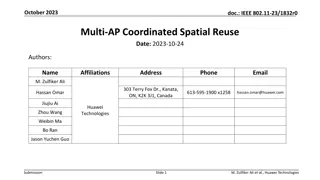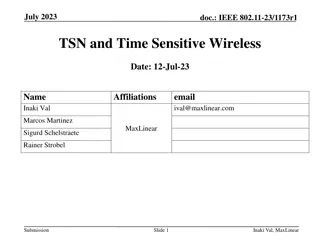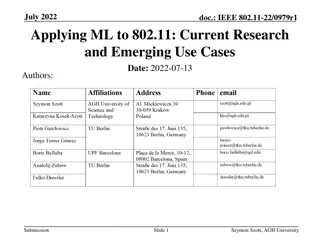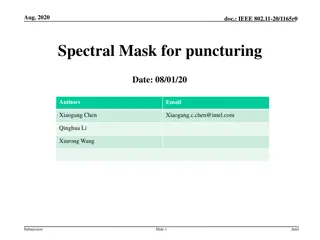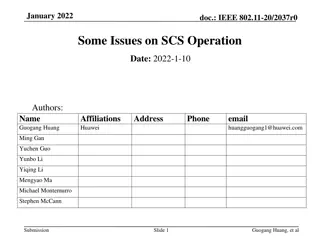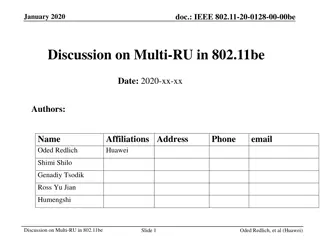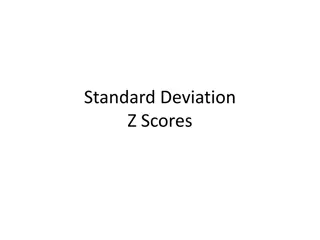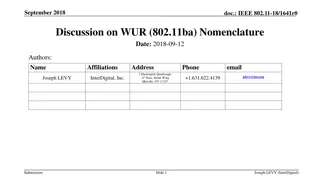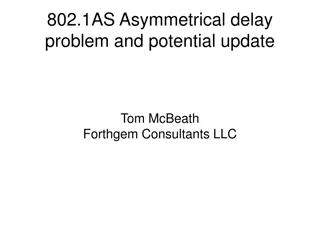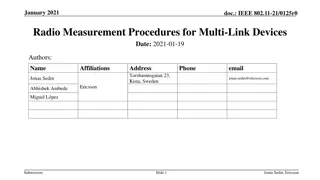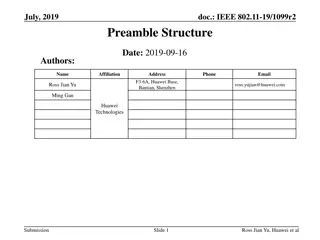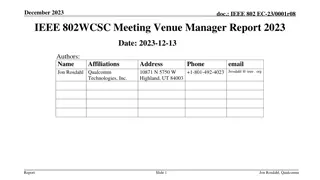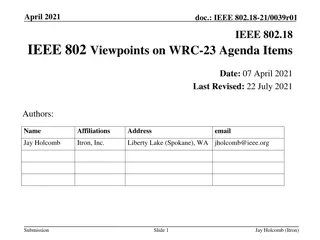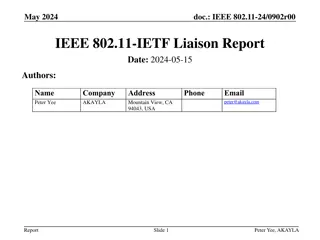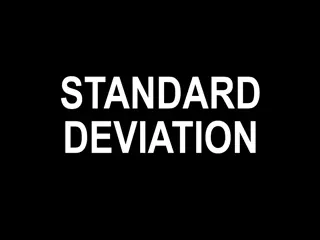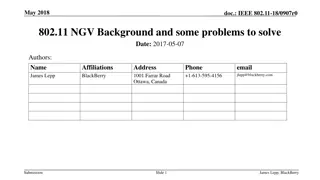Coordinated Spatial Reuse in IEEE 802.11bn Standard
This contribution explores Coordinated Spatial Reuse (Co-SR) as a potential multi-AP feature for the IEEE 802.11bn standard. It discusses the trade-offs, proposes a method for downlink channel access, and evaluates its impact on goodput and packet delivery delay. The background highlights the gains
1 views • 17 slides
Ascon: The Lightweight Cryptography Standard for IoT
The November 2023 document IEEE 802.11-23/2069r2 discusses the importance of secure data storage and communication in IoT devices due to the increasing number of connected devices and potential security threats. It introduces Ascon as a lightweight cryptography standard selected by NIST for protecti
0 views • 26 slides
Proposed Approach for MAC Address Assignment in IEEE 802.11
IEEE 802.1CQ is working on a mechanism to assign local MAC address blocks to end nodes specifically related to IEEE 802.11 standards. The current draft lacks a pre-association mechanism for IEEE 802.11 stations to obtain a local MAC address before association. The proposed remedy suggests specifying
6 views • 7 slides
IEEE 802.11-23/2092r2 AIML Report Summary
This document conveys the findings of the AIML Technical Report for IEEE 802.11 networks. It covers AIML use cases in WLANs, performance enhancement opportunities, IEEE 802.11 feature requirements, standard impacts, and proposed next steps for AIML integration. AIML's significance in various technol
3 views • 17 slides
TSN and Time Sensitive Wireless
This document explores the relationship between IEEE 802.11 and Time Sensitive Networking (TSN), defining TSN in the context of 802.11 and highlighting the importance of TSN for improving packet delivery, reducing latency, and enhancing network reliability. Various features like Multi-AP, preemption
6 views • 18 slides
Non-Primary Channel Access in IEEE 802.11-23 Standard
This document explores the concept of non-primary channel access in the IEEE 802.11-23 standard to enhance throughput and reduce latency. It discusses scenarios where stations switch to auxiliary primary channels, initiate frame exchanges, and follow back-off procedures to optimize wireless medium u
4 views • 18 slides
Proposal for Random Access Efficiency Enhancement in IEEE 802.11be Networks
This document presents a proposal for enhancing random access efficiency in IEEE 802.11be networks through a Random-Access NFRP (RA-NFRP) principle. The proposal addresses the challenges of low efficiency in the current UORA procedure and introduces modifications based on the 802.11ax standard to im
5 views • 16 slides
Exploring Machine Learning Applications in Enhancing 802.11 Performance
This document delves into recent research on utilizing machine learning (ML) to enhance 802.11 performance, focusing on emerging use cases and the increased interest in ML applications in the field since 2019. It outlines the ML areas frequently used, such as supervised learning (SL) and reinforceme
1 views • 23 slides
Proposal for Reusing ETSI Puncturing Mask in IEEE 802.11be Standard
A proposal is presented in the document IEEE 802.11-20/1165r0 discussing the possibility of reusing the ETSI-defined puncturing mask in the context of the 11be standard. The document highlights the comprehensive nature of the ETSI mask, covering various puncturing cases, and suggests that adopting t
0 views • 12 slides
Discussion on IEEE 802.11be MLD Architecture Alignment
IEEE 802.11 TGbe is exploring MLDs within the 802 architecture, focusing on aligning MLD operations with existing 802.11 features for enhanced compatibility. The MLD architecture aims to facilitate the flow of data between MAC SAPs and PHY SAPs, extending the current framework for APs and non-AP STA
1 views • 23 slides
Issues with SCS Operation in IEEE 802.11be Standard
The document discusses technical issues related to the SCS (Spatial Channel Sharing) operation in the IEEE 802.11be standard. It highlights inconsistencies in the standard regarding parameterized QoS requirements, mixing of traffic streams with different QoS needs, and challenges in prioritizing SCS
0 views • 15 slides
Discussion on Multi-RU Allocation in IEEE 802.11be Standard
In January 2020, a discussion took place on the allocation of multiple Resource Units (RUs) to a single Station (STA) in the IEEE 802.11be standard. The proposal suggested categorizing RUs into small and large types, avoiding aggregation across multiple 20MHz channels. It emphasized assigning a sing
2 views • 29 slides
Spectrum Mask Requirements in IEEE 802.11 for Punctured Transmission
The document discusses the spectrum mask requirements for punctured transmission in IEEE 802.11 standards, specifically focusing on differences between ETSI and IEEE 802.11ax spectral masks. It covers cases of puncturing scenarios and additional channel edge masks to be applied in different situatio
1 views • 16 slides
IEEE 802.11-23-1689r1 Vice Chair Report - November 2023 Plenary Session
The document presents the Vice Chair report by Jon Rosdahl from Qualcomm at the IEEE 802.11-23-1689r1 meeting in Honolulu on November 17, 2023. It covers agenda items, session information, meeting logistics, successful meeting protocols, and important event summaries. Additionally, it provides detai
1 views • 25 slides
Discussion on Enabling MIMO in IMMW: IEEE 802.11-23/1991
Enabling MIMO in mmWave technology is essential for improving throughput performance. While IEEE 802.11ad supports single-stream communications, 802.11ay introduces SU-MIMO, MU-MIMO, and hybrid beamforming. This document discusses the necessity of MIMO in IMMW and explores various MIMO options for e
2 views • 12 slides
IEEE 802.11-20/0021-00 Priority Access Support for NS/EP Services Overview
This document discusses the importance of priority access support in IEEE 802.11be for National Security and Emergency Preparedness (NS/EP) services. It outlines the need for standardized mechanisms to ensure priority services in WLAN networks during NS/EP events when cellular coverage is unavailabl
1 views • 15 slides
Understanding Standard Deviation, Variance, and Z-Scores
Explore the importance of variation in interpreting data distributions, learn how to calculate standard deviation, understand z-scores, and become familiar with Greek letters for mean and standard deviation. Discover the significance of standard deviation in statistical analysis and the difference b
1 views • 18 slides
Evaluation of IEEE 802.11ax for IMT-2020 eMBB Dense Urban Test Environment
This document discusses the evaluation of IEEE 802.11ax technology in the context of the IMT-2020 Enhanced Mobile Broadband (eMBB) Dense Urban test environment. It analyzes the performance of 802.11ax in meeting the key PHY/MAC metrics required for eMBB Dense Urban scenarios, such as Peak Spectral E
2 views • 13 slides
IEEE 802.11-19-0202/r1 TGbd Agreed Terminology and Requirements
This document outlines the agreed terminology and requirements for the development of the next generation of IEEE 802.11p technology within IEEE 802.11bd Task Group. It covers aspects such as interoperability, co-existence, backward compatibility, and fairness between IEEE 802.11p and IEEE 802.11bd
0 views • 6 slides
Workplace Exposure Standard for Silica Dust in Stone Benchtop Fabrication
Reduction in workplace exposure standard for respirable crystalline silica dust has been implemented, halving the national standard to 0.05 mg/m3. The new standard aims to protect workers in stone benchtop fabrication businesses from serious lung diseases caused by breathing in silica dust. Employer
1 views • 8 slides
Discussion on Proposed Nomenclature for IEEE 802.11ba Standard
This document presents a discussion on the proposed nomenclature for the IEEE 802.11ba standard draft amendment, highlighting the need for clarity and consistency in terminology to avoid confusion and specification issues. Various new terms and definitions are suggested for different types of device
0 views • 13 slides
IEEE 802.11be MLD Architecture Discussion
The document discusses the architecture of MLD (Multicast and Local Delivery) within the IEEE 802.11be framework. It highlights how MLD will align with existing 802.11 basic architecture, emphasizing the management of access to PHY and media for both AP and non-AP devices. The goal is to integrate M
0 views • 9 slides
Time-Aware Scheduling Capabilities in IEEE 802.11be
Describing necessary enhancements to enable Time-Aware Scheduling in IEEE 802.11be for time-sensitive applications. The focus is on aligning with the 802.1Qbv standard to address latency, jitter, and reliability issues, presenting a structured outline of requirements and configurations essential for
0 views • 24 slides
Wireless TSN in 802.11: New Requirements and Integration with 802.1
This document discusses the extension of TSN capabilities from wired to wireless networks, focusing on potential enhancements for 802.11be and integration with Ethernet-based TSN standards. It covers topics such as time-sensitive applications, TSN toolbox overview, status of TSN capabilities support
4 views • 12 slides
LDPC Investigation for IEEE 802.11bd Technology in March 2019
In March 2019, the document IEEE 802.11-19/0346r3 delves into the investigation of LDPC (Low-Density Parity-Check) codes for the advancement of 11bd technology. The authors from Marvell explore the potential benefits of LDPC over BCC (Block Code Concatenation) in achieving better sensitivity for 802
0 views • 15 slides
Evolution of Standards: IEEE 802.11 and 802.1D Relationship
Explore the relationship between IEEE 802.11 and 802.1D standards, discussing the necessity of referencing old standards, the state of 802.1D, and the potential for removing outdated references in 802.11. The submission proposes a migration model while emphasizing the importance of staying current w
0 views • 42 slides
IEEE Std. 802.11-22/1017r0 Overview and Architecture Presentation
This presentation by Dorothy Stanley from HP Enterprise delves into the utilization of IEEE Std. 802.11-2020 standards focusing on the IEEE Std. 802 overview and architecture. It covers topics such as the use of LLC, MAC address formats, QoS mechanisms, MSDU formats, and various MAC services and pro
0 views • 10 slides
Enhancing HARQ Framing for IEEE 802.11 Standards
Hybrid-ARQ (HARQ) is a candidate topic for TGbe presentations in IEEE 802.11 standards. Despite previous unsuccessful attempts, there is renewed interest in enabling HARQ through framing support. This document discusses the importance of presenting HARQ framing, outlining the necessary information a
1 views • 7 slides
Understanding Asymmetrical Delay in Networking
The content discusses the impact of asymmetrical delay in networking scenarios, focusing on how it can affect different applications such as audio, video, and industrial machinery. Through examples and diagrams, the potential issues of accumulated delays and closed gates in protocols like 802.1Qbv a
0 views • 16 slides
Privacy Issues in IEEE 802.11 Networks: Tracking and MAC Randomization
This presentation delves into the privacy concerns surrounding 802.11 networks, focusing on tracking vulnerabilities and the limitations of MAC randomization in preventing tracking. It discusses the ease of tracking devices, the risk of passive tracking due to MAC addresses being visible in frames,
0 views • 27 slides
IEEE 802.11-21/0125r0 Radio Measurement Procedures for Multi-Link Devices
The IEEE 802.11 WLAN standard introduces the concept of Multi-Link Devices (MLD) in the 802.11be (EHT) amendment, enabling multiple affiliated STAs to work together. This document focuses on enhancing radio measurement procedures for MLDs to boost efficiency and flexibility in managing radio resourc
0 views • 14 slides
IEEE 802.15 Standards Progress Report July 2024
The document provides updates on various IEEE 802.15 standards development activities in March 2024. Progress reports on IEEE 802.15.4 Rev.E, TG.4ad Amendment, and 802.15.4ab Next Generation UWB are outlined. Resolutions, approval statuses, and future development plans are detailed for each standard
0 views • 12 slides
IEEE 802.11-19/1099r2 Preamble Structure Overview
The document discusses the specific preamble structures of IEEE standards such as 802.11n, 802.11ac, and the newer 802.11ax (11ax). It explores the functionalities provided by these preambles including synchronization, auto-detection, channel estimation, and more. The focus is on how different stand
0 views • 13 slides
IEEE 802.1CQ: Address Assignment and Validation Protocols
This document explores the assignment and validation of unicast addresses within IEEE 802 networks, emphasizing the need for uniqueness to prevent operational errors and security breaches. It discusses the challenges of ensuring globally-unique addresses, proposing the implementation of a single val
0 views • 6 slides
IEEE 802 Wireless Meeting Venue Reports and Future Plenary Contracts Update
Jon Rosdahl from Qualcomm provided updates on the current status of 802 Wireless Interim Session venue plans, a recap of 802 Executive Committee decisions, and future 802 Plenary venue contract statuses up to 2027. The presentation highlighted selected venues, open dates, and upcoming contracts for
0 views • 56 slides
Suitability of IEEE 802.11ah for LPWAN Applications Analysis
This document analyzes the suitability of IEEE 802.11ah for Low Power Wide Area Network (LPWAN) applications. It examines the features of IEEE 802.11ah, such as OFDM-based FEC and its performance in fulfilling LP-WAN use-cases. The document also discusses channel models, interference resistance, and
0 views • 22 slides
IEEE 802 Viewpoints on WRC-23 Agenda Items
This document presents IEEE 802's viewpoints on Agenda Items related to current IEEE 802 standards activities for the WRC-23. It reflects the perspectives of IEEE 802 and provides insights on various AI topics such as frequency bands and IMT multiple bands. The document offers analysis and considera
0 views • 9 slides
IEEE 802.11-IETF Liaison Report May 2024
This document presents the IEEE 802.11-IETF liaison report for May 2024, covering upcoming IETF meetings, coordination activities, protocol use with 802.11 technology, BOFs at IETF 120, and IETF/IRTF group charters. It mentions important updates and considerations for IEEE 802 parameters and technol
0 views • 19 slides
Understanding Standard Deviation and Standard Error of the Means
Standard deviation measures the variability or spread of measurements in a data set, while standard error of the means quantifies the precision of the mean of a set of means from replicated experiments. Variability is indicated by the range of data values, with low standard deviation corresponding t
0 views • 7 slides
Challenges and Proposed Solutions in Next-Generation Vehicle Technologies
The document discusses the background of IEEE 802.11 NGV technologies, focusing on the need for a new 10 MHz PHY for DSRC systems. It highlights issues related to channelization and introduces new PHY capabilities in 802.11n, 802.11ac, and draft 802.11ax standards, offering insights into evolving fe
0 views • 14 slides
